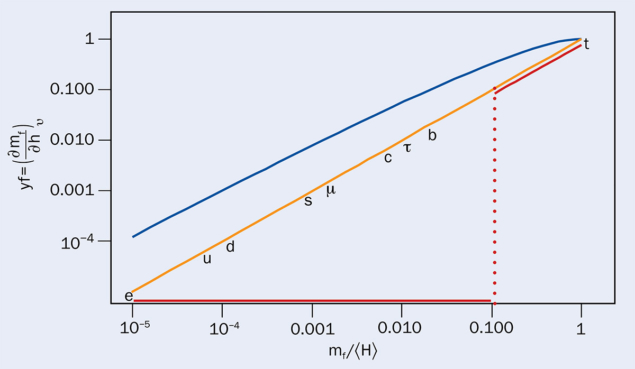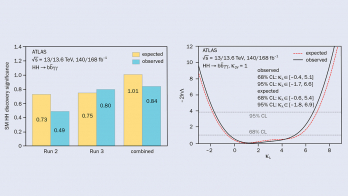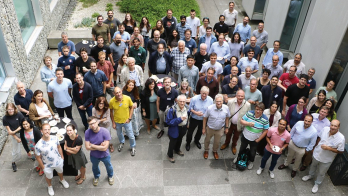Gilad Perez links the Higgs boson to the puzzling pattern of the fermion masses.
For thousands of years, humans have asked “what are the building blocks of nature?” To those not familiar with the wonders of relativistic quantum mechanics, the question might seem equivalent to asking “what are the smallest particles known?” However, we know that the size of atoms is quantised, and has negligible dependence on the size of nuclei. In fact, atomic size is essentially inversely proportional to the mass of the electron. Therefore, it is the electron mass, in addition to the rules of quantum mechanics, that essentially controls all the inner structure of all the elements. Furthermore, the masses and sizes of nuclei, protons and neutrons cannot simply be obtained by “adding up” smaller degrees of freedom; they are rather dictated by the coupling constant of the strong force, which below a certain energy scale, ΛQCD, becomes so large that the force between two particles becomes approximately independent of their distance, inducing confinement.
The above description suggests that “all” that is required to understand the basic structure of matter is to understand the origin of the electron mass and to study quantum chromodynamics. But this misses the bigger picture revealed by the Standard Model (SM). Protons, neutrons and other light, long-lived baryons are the lightest excitations of the pion field, which is constructed from the ultra-light u and d quarks, and perhaps also s quarks. This reveals the profound importance of the values of the fermion masses: increasing the u and d mass difference by less than 10 MeV (that is, about 1% of the proton mass), for instance, would make hydrogen and its isotopes unstable, thereby preventing the formation of almost all the elements in the early universe. Indeed, there are only certain regions in the vast quark-mass and ΛQCD parameter space that enable the universe as we know it to form.

Having established that the structure of the masses of the elementary particles is an existential issue, what does this have to do with the discovery of the Higgs boson? While the Higgs boson carries a cosmological background value called the vacuum expectation value (VEV), which is associated with the spontaneous breaking of the electroweak symmetry, the VEV is not necessarily the source of the actual value and/or the pattern of fermion masses. The reason is that, in addition to baryonic charge (or number), all the elementary charged particles carry “chiral charge” – they are either left- or right-handed – which is conserved in the absence of the Brout–Englert–Higgs (BEH) field. What is fascinating about the BEH mechanism is that with the appropriate choice of coupling, the product of the field and its coupling-strength to the fermions effectively becomes a source of chiral charge, allowing the fermions to interact with it; the VEV is merely the constant of proportionality that induces the masses of the fermions (and of the weak-force mediators). This is a very minimal setup! In other known symmetry-breaking frameworks – for instance models based on technicolour/QCD-like dynamics or on superconductivity, where the electromagnetic symmetry inside a superconductor is broken by a condensate of electrons denoted Cooper pairs – there is no direct link to the generation of fermion masses.
Standard Model couplings
The BEH mechanism might be minimal, but it still involves many parameters. The origin of fundamental masses requires switching on nine trilinear-couplings, which are broken into three generations of fundamental particles: three involving the u-type left- and right-handed quarks (u, c, t), three involving the d-type left- and right-handed quarks (d, s, b) and three involving the left- and right-handed charged leptons (e, µ, τ). Each coupling is associated with a linear “Yukawa” coupling of the Higgs boson to fermions, which implies that all the charged fermions acquire a mass proportional to the VEV of the BEH field. In other words, there is a linear relation between the Yukawa coupling and the fermion masses. Strikingly, the observed fermion masses encoded in the Yukawa couplings span some five orders of magnitude, with all but some members of the third generation being extremely small – leading to the fermion mass-hierarchy puzzle.

The coupling between the Higgs boson and the fermions can be pictured as a new force – one that is radically different to the SM gauge forces. Given that this force only works between two particles that are closer than around 10–18 m – i.e. 1000 times smaller than the proton radius – it is not relevant to any experimental setup. The Higgs–Yukawa couplings do, however, conceal two interesting aspects related to our existence. The first is that increasing the VEV by a few factors would increase the neutron–proton mass splitting to the point where all nuclei are unstable. The second, pointed out by Giuseppe Degrassi and co-workers in 2013, is that the top-quark Yukawa interaction is close to its maximal size: increasing it by as little as 10% would push the VEV to fantastically large values, rendering our current universe unstable (see The Higgs and the fate of the universe).
Massive alternatives
The minimal BEH mechanism is not the only way to understand the fermion mass hierarchy. This is illustrated by two radically different options. In the first, proposed in 2008 by Gian Giudice and Oleg Lebedev, the Yukawa couplings are assumed to depend on the BEH field, therefore avoiding hierarchies in the Yukawa couplings. The idea postulates a variation of chiral symmetry (in which the lighter the fermion the more chiral charge it carries) that forbids lighter particles from coupling to the Higgs linearly, but instead generates their masses through appropriate powers of the VEV (see “In line” figure, blue curve). The other extreme possibility, discussed more recently by the present author and colleagues, is where the masses of the light fermions instead come from their interaction with a subdominant additional source of electroweak symmetry breaking, similar to the technicolour framework. This new source replaces the Higgs boson’s role as the carrier of the light-generation chiral-charge, causing the light fermion-Higgs couplings to vanish (see figure, red curve). Both cases lead to an alternative understanding of the mass hierarchy puzzle and to the establishment of new physics.
The conclusion is that measuring the fermion-Higgs couplings at higher levels of precision will significantly improve our understanding of the origin of masses in nature. It took a few years after the Higgs-boson discovery, around 2018, for ATLAS and CMS to establish that the standard BEH mechanism is behind the third-generation fermion masses. This is a legacy result from the LHC experiments that is sometimes overlooked by our community (CERN Courier September/October 2020 p41). While significant, however, it told us little about the origin of the matter in the universe, which is almost exclusively made out of first-generation fermions with extremely small couplings to the Higgs boson. So far, we only have indirect information, via Higgs-boson couplings to the gauge bosons, about the origin of mass of the first and second generations. But breakthroughs are imminent. In the past two years, ATLAS and CMS have found signs that the Higgs boson contributes to both the second-generation muon and charm masses, which would exclude models leading to both the blue and red curves in the figure. Measuring the smallest electron Yukawa coupling is only possible at a future collider, whereas for the u and d quarks there is no clear experimental pathway.
Experimental novelties
A recent, unexpected way to tackle the mystery of fermion masses involves dark matter, specifically a class of models in which the dark-matter particle is ultra-light and its field-value oscillates with time. Such particles would couple to fermions in a way that echoes the Higgs–Yukawa coupling, though with an extremely low interaction strength, and lead to a variation in the masses of the fundamental fermions with time. This feeble effect cannot be searched for at colliders, but it can be probed with quantum sensors such as atomic clocks or future nuclear clocks that reach sensitivity of one part in 1019 or more. The strongest sensitivity of these tabletop experiments is the one to the electron mass.
It is now a priority to directly test the mass-generating mechanism of the first two generations
The discovery of the Higgs boson has opened a new window on the origin of masses, and consequently the structure of the basic blocks of nature, with profound links to our existence. ATLAS and CMS have made several breakthroughs, including the observation that the third-generation masses originate from the SM minimal BEH mechanism, and also providing evidence for part of the second-generation fermions. It is now a priority to directly test the mass-generating mechanism of the first two generations, and to determine all the Higgs couplings at higher precision, in search of possible chinks in the SM armour.








